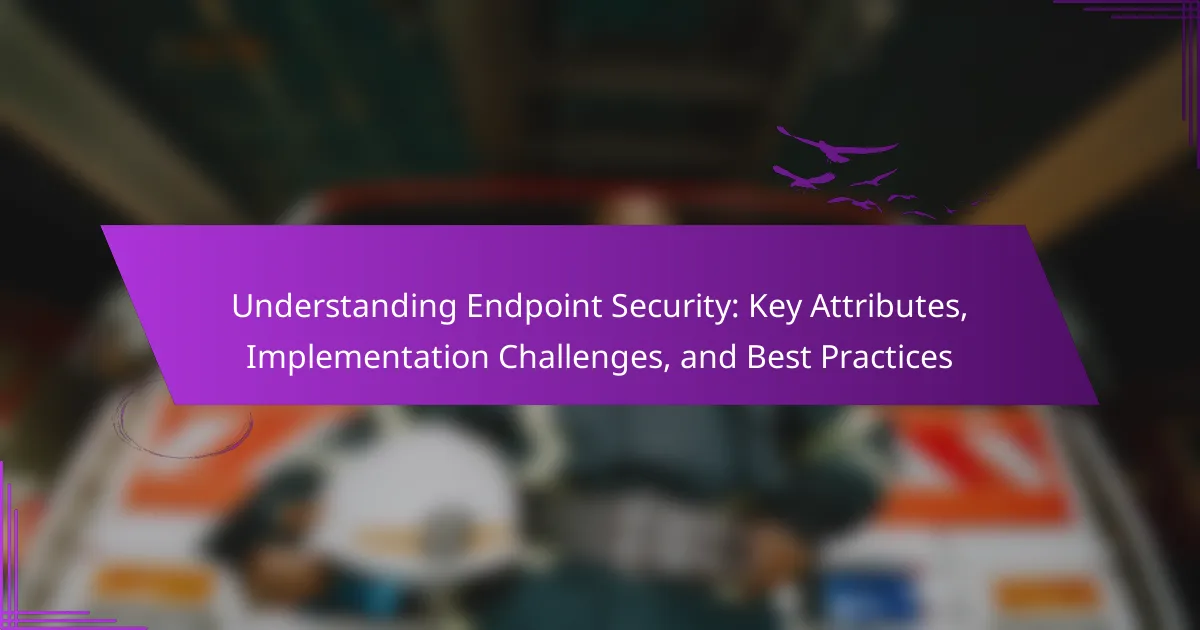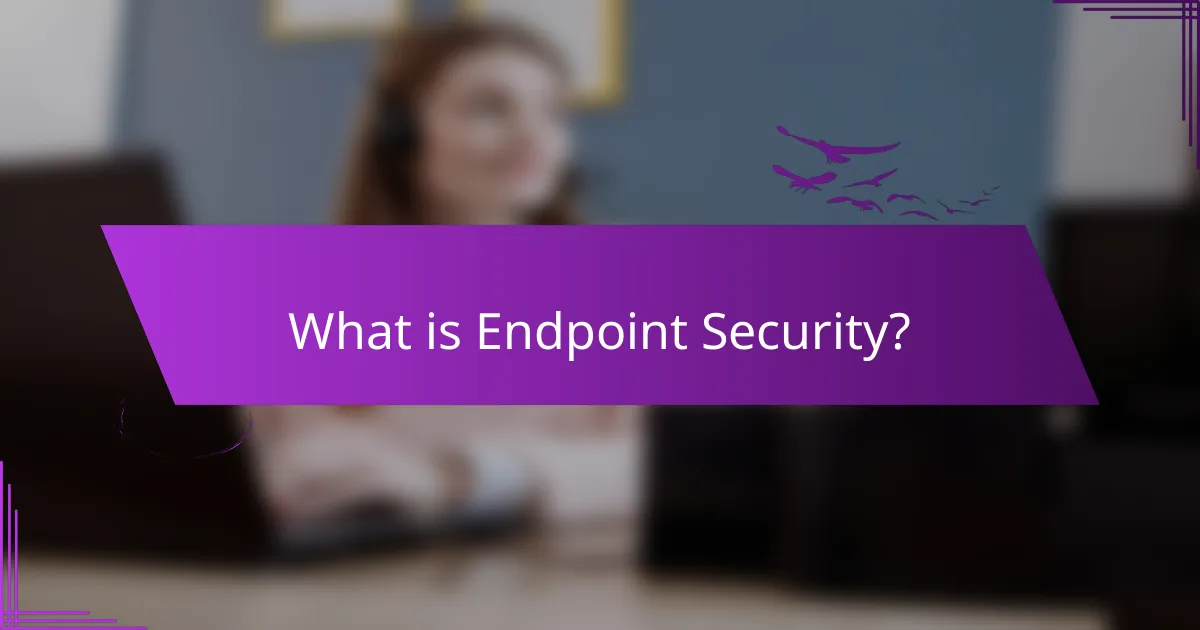
What is Endpoint Security?
Endpoint security is a cybersecurity approach that protects endpoints on a network. Endpoints include devices like laptops, desktops, and mobile devices. This security strategy aims to prevent unauthorized access and threats. It employs various tools such as antivirus software, firewalls, and intrusion detection systems. Endpoint security solutions monitor and manage these devices to detect vulnerabilities. According to a report by Cybersecurity Insiders, 68% of organizations feel their endpoint security is inadequate. This highlights the importance of robust endpoint security measures in modern networks.
How does Endpoint Security protect devices?
Endpoint Security protects devices by implementing a range of security measures. These measures include antivirus protection, firewalls, and intrusion detection systems. Endpoint Security monitors device activity to detect and respond to threats in real-time. It also enforces security policies to ensure compliance and reduce vulnerabilities. By using encryption, Endpoint Security protects sensitive data from unauthorized access. Regular updates and patches are applied to safeguard against the latest threats. According to a study by Gartner, organizations that implement Endpoint Security solutions reduce the risk of data breaches significantly.
What types of threats does Endpoint Security address?
Endpoint Security addresses various types of threats including malware, ransomware, and phishing attacks. Malware refers to malicious software designed to harm or exploit devices. Ransomware encrypts a user’s files, demanding payment for decryption. Phishing attacks trick users into revealing sensitive information through deceptive emails or websites. Additionally, Endpoint Security protects against data breaches and insider threats, which can compromise sensitive information. These threats can lead to significant financial and reputational damage for organizations. According to a report by Cybersecurity Ventures, cybercrime is projected to cause $10.5 trillion annually by 2025, highlighting the importance of effective Endpoint Security solutions.
What are the key components of Endpoint Security solutions?
The key components of Endpoint Security solutions include antivirus software, firewalls, intrusion detection systems, and data encryption. Antivirus software protects endpoints from malware and viruses. Firewalls monitor and control incoming and outgoing network traffic. Intrusion detection systems identify and respond to potential threats in real-time. Data encryption secures sensitive information on devices. Additionally, endpoint security solutions often incorporate threat intelligence and endpoint detection and response (EDR) capabilities. These components work together to create a comprehensive security posture for devices connected to a network.
Why is Endpoint Security important for organizations?
Endpoint security is crucial for organizations because it protects devices that connect to their networks. These devices are often entry points for cyber threats. Effective endpoint security safeguards sensitive data from breaches and unauthorized access. According to a report by Cybersecurity Ventures, cybercrime is projected to cost the world $10.5 trillion annually by 2025. This highlights the financial risks organizations face without adequate endpoint protection. Furthermore, endpoint security solutions can detect and respond to threats in real-time. This capability minimizes potential damage and ensures business continuity. Organizations that invest in endpoint security demonstrate a commitment to safeguarding their assets and maintaining customer trust.
How does Endpoint Security contribute to overall cybersecurity?
Endpoint security is crucial for overall cybersecurity as it protects endpoints from threats. Endpoints include devices like laptops, smartphones, and servers. These devices often serve as entry points for cyberattacks. By implementing endpoint security measures, organizations can detect and respond to threats quickly. This reduces the risk of data breaches and malware infections. According to a report by Cybersecurity Insiders, 68% of organizations feel their endpoint security is inadequate. Effective endpoint security solutions also provide real-time monitoring and threat intelligence. This enhances the organization’s ability to maintain a secure network environment. Overall, endpoint security is a foundational element of a comprehensive cybersecurity strategy.
What are the potential risks of inadequate Endpoint Security?
Inadequate endpoint security poses significant risks to organizations. These risks include data breaches, which can lead to unauthorized access to sensitive information. Malware infections are another risk, potentially disrupting operations and compromising data integrity. Additionally, inadequate security increases vulnerability to ransomware attacks, resulting in financial losses and operational downtime. Insider threats may also arise, as weak security can allow malicious insiders to exploit systems. Compliance violations can occur, leading to legal repercussions and financial penalties. Furthermore, the overall reputation of an organization can suffer due to security incidents, eroding customer trust. According to a report by Cybersecurity Ventures, cybercrime costs are projected to reach $10.5 trillion annually by 2025, underscoring the importance of robust endpoint security measures.
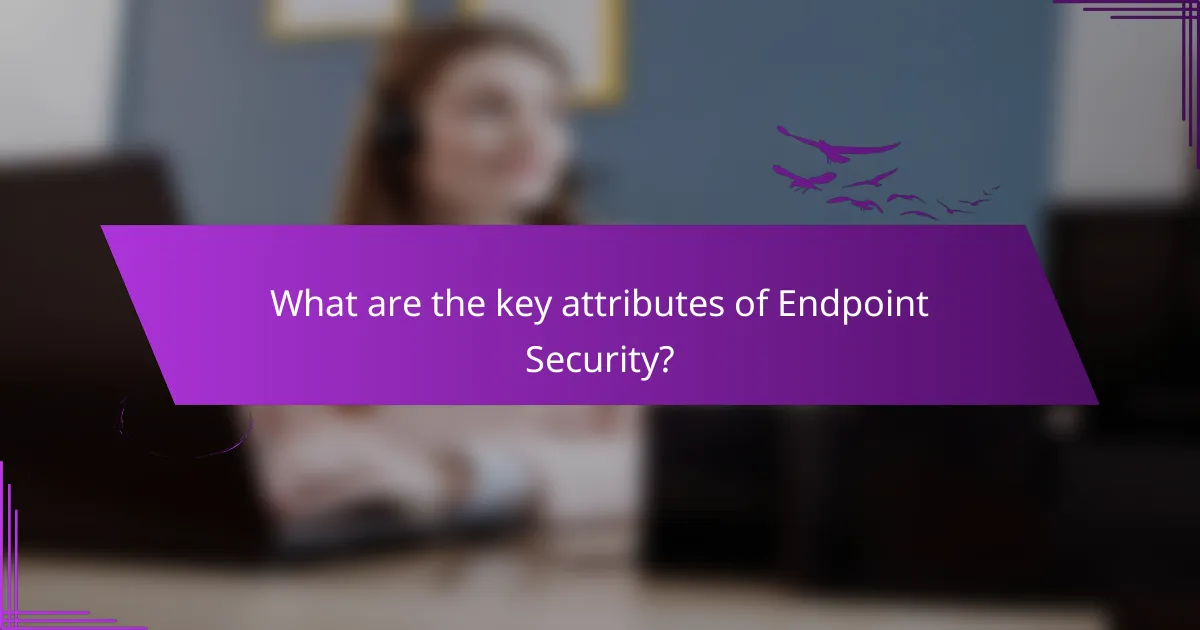
What are the key attributes of Endpoint Security?
The key attributes of Endpoint Security include threat detection, data protection, and device management. Threat detection identifies and responds to potential security breaches. Data protection safeguards sensitive information from unauthorized access and breaches. Device management ensures all endpoints are monitored and updated regularly. Additionally, endpoint security offers real-time monitoring to detect anomalies. It also provides user authentication to verify identities before granting access. These attributes collectively enhance the overall security posture of an organization’s network.
What features should an effective Endpoint Security solution have?
An effective Endpoint Security solution should have comprehensive threat detection capabilities. This includes real-time monitoring to identify malicious activities. It should also feature automated response mechanisms to mitigate threats swiftly. Additionally, the solution must support regular updates to combat emerging vulnerabilities. User behavior analytics can enhance detection by identifying anomalies. Integration with existing security infrastructure is crucial for seamless operation. Finally, it should provide detailed reporting for compliance and analysis purposes. These features collectively ensure robust endpoint protection against a variety of threats.
How do advanced threat detection and response capabilities work?
Advanced threat detection and response capabilities work by utilizing sophisticated algorithms and machine learning techniques. These systems analyze vast amounts of data to identify anomalies indicative of potential threats. They monitor network traffic, endpoint behavior, and user activities in real-time. When a threat is detected, these capabilities automatically initiate response mechanisms. This may include isolating affected systems or blocking malicious activities. Advanced threat detection uses threat intelligence to enhance accuracy. It correlates data from various sources to improve detection rates. These systems continuously learn from new threats to adapt their response strategies.
What role does encryption play in Endpoint Security?
Encryption is a critical component of endpoint security. It protects sensitive data stored on devices from unauthorized access. By encrypting data, organizations ensure that even if a device is compromised, the information remains unreadable without the decryption key. This is particularly important for mobile devices and laptops that may be lost or stolen. Encryption also secures data in transit, preventing interception during communication between endpoints and servers. According to the 2021 Verizon Data Breach Investigations Report, 46% of data breaches involved compromised endpoints. Therefore, implementing encryption significantly reduces the risk of data breaches and enhances overall security posture.
How does Endpoint Security integrate with other security measures?
Endpoint security integrates with other security measures by providing a comprehensive defense against threats. It works alongside firewalls, intrusion detection systems, and antivirus software to enhance overall security. This integration allows for real-time threat detection and response across multiple layers of security. For example, endpoint security can share threat intelligence with network security solutions. This collaboration improves visibility and helps in identifying potential vulnerabilities. Additionally, endpoint security solutions often include features like data encryption and access controls. These features complement existing security measures by safeguarding sensitive information. The result is a more robust security posture that addresses both endpoint and network-level threats.
What is the relationship between Endpoint Security and network security?
Endpoint security focuses on protecting individual devices within a network. Network security, on the other hand, aims to protect the entire network infrastructure. Both are essential for comprehensive cybersecurity. Endpoint security serves as the first line of defense against threats targeting devices. Network security provides a broader protective barrier against external attacks. The effectiveness of endpoint security enhances the overall security posture of the network. Conversely, strong network security can help safeguard endpoints from external threats. Together, they create a multi-layered security strategy that addresses various vulnerabilities.
How can Endpoint Security support compliance requirements?
Endpoint security supports compliance requirements by ensuring that devices adhere to regulatory standards. It implements security policies that protect sensitive data. This includes encryption, access controls, and regular security updates. By monitoring endpoints, organizations can detect and respond to security incidents promptly. Compliance frameworks often require such proactive measures to safeguard information. For example, regulations like GDPR and HIPAA mandate strict data protection protocols. Endpoint security solutions help organizations demonstrate compliance through audit trails and reporting features. This documentation is crucial during compliance assessments and audits.
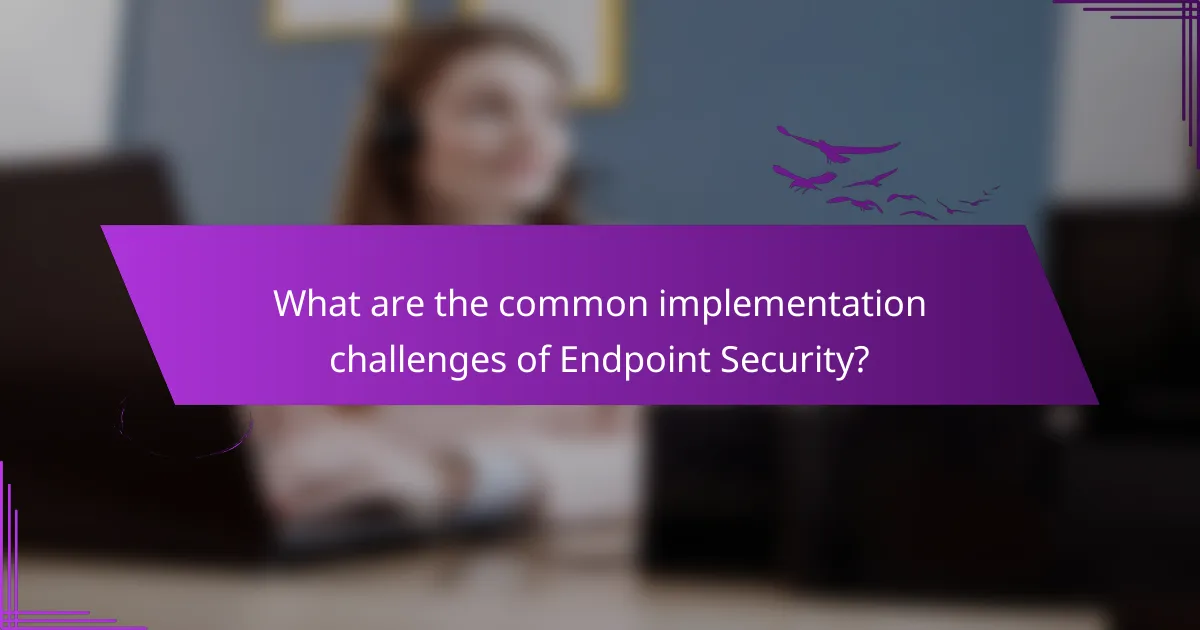
What are the common implementation challenges of Endpoint Security?
Common implementation challenges of endpoint security include complexity, user resistance, and integration issues. Complexity arises from managing diverse devices and operating systems. User resistance often stems from perceived inconvenience or reduced performance. Integration issues occur when security solutions do not seamlessly connect with existing IT infrastructure. Additionally, maintaining consistent policy enforcement across all endpoints can be difficult. Limited visibility into endpoint activity complicates threat detection. Resource constraints, such as budget and personnel, further hinder effective implementation. These challenges highlight the need for strategic planning and robust solutions in endpoint security deployment.
What obstacles do organizations face when deploying Endpoint Security?
Organizations face several obstacles when deploying Endpoint Security. One major challenge is the complexity of integration with existing systems. Many organizations have diverse IT environments, making seamless integration difficult. Additionally, there is often a lack of skilled personnel to manage and maintain Endpoint Security solutions. This skills gap can hinder effective implementation.
Another obstacle is the potential for increased operational costs. Organizations may face budget constraints that limit their ability to invest in comprehensive security solutions. User resistance is also a common issue. Employees may be reluctant to adopt new security measures, fearing disruptions to their workflow.
Furthermore, organizations must contend with evolving cyber threats. The constantly changing landscape of malware and attack vectors requires continuous updates and adaptations to security protocols. Lastly, regulatory compliance can pose challenges. Organizations must ensure their Endpoint Security measures meet industry standards and legal requirements.
How can resistance to change affect Endpoint Security implementation?
Resistance to change can significantly hinder Endpoint Security implementation. It leads to employee reluctance in adopting new security protocols. This reluctance can result in inconsistent security practices across the organization. Inconsistent practices increase vulnerability to cyber threats. Additionally, resistance can slow down the deployment of necessary security updates. Delayed updates can leave systems exposed to known vulnerabilities. A study by IBM shows that organizations with high employee resistance experience 30% more security breaches. Therefore, addressing resistance is crucial for effective Endpoint Security implementation.
What technical challenges may arise during deployment?
Technical challenges during deployment may include compatibility issues, network configuration errors, and resource limitations. Compatibility issues arise when endpoint security solutions do not integrate well with existing systems. Network configuration errors can lead to miscommunication between devices, hindering functionality. Resource limitations may prevent adequate system performance, affecting security measures. Additionally, user resistance can complicate the implementation process. Training and support are often necessary to overcome these challenges. According to a survey by the Ponemon Institute, 60% of organizations report deployment difficulties due to these technical issues.
How can organizations overcome these implementation challenges?
Organizations can overcome implementation challenges by adopting a structured approach. They should start with a comprehensive assessment of their current security posture. This assessment helps identify vulnerabilities and areas needing improvement. Next, organizations must prioritize employee training and awareness to ensure everyone understands security protocols. Implementing user-friendly technologies can also reduce resistance to new systems. Regular updates and maintenance of security tools are essential to address emerging threats. Additionally, organizations should establish clear policies and procedures to guide security practices. Collaborating with IT security experts can provide valuable insights and support. Finally, continuous monitoring and feedback loops help refine security strategies over time.
What strategies can improve user adoption of Endpoint Security solutions?
Effective strategies to improve user adoption of Endpoint Security solutions include comprehensive training programs and user-friendly interfaces. Training programs should focus on educating users about the risks of cyber threats and the importance of security measures. According to a study by the Ponemon Institute, organizations that invest in security awareness training see a 70% reduction in phishing incidents.
User-friendly interfaces enhance engagement and reduce frustration. Solutions that simplify processes encourage users to adopt security measures without feeling overwhelmed. Regular feedback from users can help refine these interfaces.
Additionally, involving users in the selection and implementation process fosters a sense of ownership. When users feel their input is valued, they are more likely to embrace the solution. Clear communication regarding the benefits of Endpoint Security also plays a crucial role. Highlighting how these solutions protect personal and organizational data can motivate users to comply with security protocols.
In summary, training, user-friendly design, user involvement, and clear communication are key strategies for improving user adoption of Endpoint Security solutions.
How can proper training mitigate implementation issues?
Proper training can mitigate implementation issues by ensuring that employees understand the endpoint security protocols. Knowledgeable staff can identify potential threats and respond effectively. Training enhances skills in using security tools and software. It also promotes adherence to best practices in data protection. According to a 2021 study by the Ponemon Institute, organizations with comprehensive training programs experience 45% fewer security incidents. This statistic underscores the importance of training in reducing human error. Ultimately, well-trained employees contribute to a stronger security posture and smoother implementations.
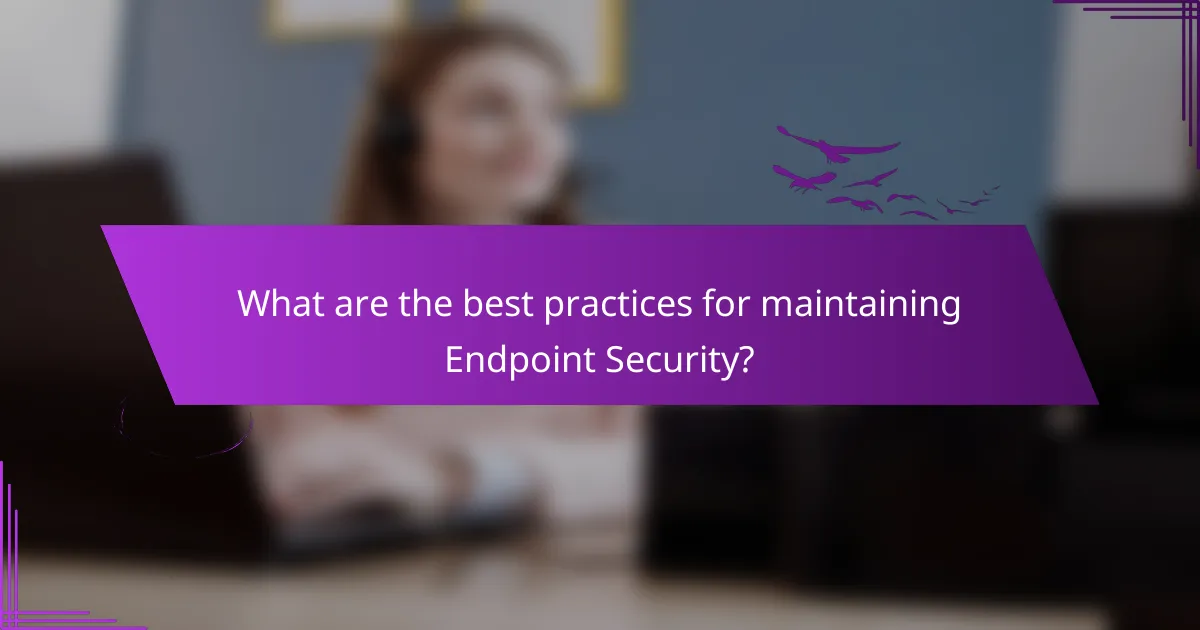
What are the best practices for maintaining Endpoint Security?
Regularly update software and operating systems to patch vulnerabilities. This practice reduces the risk of exploitation. Implement strong password policies to enhance access control. Require multi-factor authentication to add an extra layer of security. Use endpoint detection and response (EDR) solutions for real-time monitoring. This allows for quick identification of threats. Conduct regular security training for employees to raise awareness. Educated users are less likely to fall for phishing attacks. Limit user privileges to only what is necessary for their roles. This minimizes potential damage from compromised accounts. Regularly back up data to secure locations to prevent data loss. This ensures quick recovery in case of an incident.
How often should Endpoint Security solutions be updated?
Endpoint Security solutions should be updated regularly, ideally at least once a week. Frequent updates ensure that the software can defend against the latest threats. Cyber threats evolve rapidly, necessitating timely updates to maintain security. According to the Cybersecurity and Infrastructure Security Agency (CISA), regular updates are crucial for protecting systems from vulnerabilities. They recommend updating endpoint solutions as soon as new patches or definitions are available. This proactive approach minimizes the risk of exploitation. Additionally, organizations should monitor threat intelligence to inform update frequency. Overall, consistent updating is essential for effective endpoint protection.
What is the importance of regular security assessments?
Regular security assessments are crucial for identifying vulnerabilities in an organization’s systems. These assessments help in evaluating the effectiveness of existing security measures. They also ensure compliance with industry regulations and standards. Regular assessments can prevent data breaches by identifying weaknesses before they can be exploited. According to a study by the Ponemon Institute, organizations that conduct regular security assessments reduce their risk of a data breach by 50%. Additionally, continuous monitoring and assessment can adapt to evolving threats. This proactive approach enhances overall security posture and builds stakeholder trust.
How can organizations ensure ongoing compliance with security policies?
Organizations can ensure ongoing compliance with security policies by implementing regular training and awareness programs. These programs educate employees about the importance of security measures. Regular audits and assessments help identify compliance gaps. Automated compliance monitoring tools can track adherence to security policies in real-time. Establishing a culture of security within the organization promotes accountability. Clear documentation of policies and procedures supports compliance efforts. Engaging with external security consultants can provide additional insights. These strategies collectively enhance an organization’s ability to maintain compliance effectively.
What practical tips can enhance Endpoint Security effectiveness?
Implementing strong endpoint security requires several practical tips. First, regularly update software and operating systems to patch vulnerabilities. Research shows that 60% of breaches occur due to unpatched software. Second, utilize robust antivirus and anti-malware solutions to detect and mitigate threats. According to a report by AV-Test, effective antivirus software can prevent over 99% of malware attacks. Third, enforce strong password policies and multi-factor authentication to enhance access controls. Studies indicate that multi-factor authentication can block up to 99.9% of account compromise attacks. Fourth, conduct regular security training for employees to raise awareness about phishing and social engineering attacks. Data from the Ponemon Institute reveals that organizations with regular training reduce phishing susceptibility by 70%. Lastly, implement endpoint detection and response (EDR) tools for real-time monitoring and threat detection. EDR solutions can improve incident response times by 50%, as stated by a report from Cybersecurity Ventures.
How can user awareness training improve Endpoint Security outcomes?
User awareness training can significantly improve Endpoint Security outcomes by equipping employees with the knowledge to recognize threats. It educates users about common cyber threats such as phishing and malware. When users are aware of these risks, they are less likely to fall victim to attacks. Studies show that organizations with awareness training experience a 70% reduction in security incidents. This training fosters a culture of security mindfulness among employees. Increased vigilance leads to early detection of potential threats. Consequently, this proactive approach can prevent data breaches and financial losses. Ultimately, user awareness training enhances the overall security posture of an organization.
What role does incident response planning play in Endpoint Security?
Incident response planning is crucial for effective endpoint security. It provides a structured approach to identify, manage, and mitigate security incidents involving endpoints. This planning ensures that organizations can respond quickly to threats, minimizing potential damage. A well-defined incident response plan outlines roles, responsibilities, and procedures for incident detection and containment. According to the 2021 Verizon Data Breach Investigations Report, organizations with an incident response plan can reduce the time to contain breaches significantly. This highlights the importance of proactive planning in safeguarding endpoint security.
Endpoint security is a cybersecurity strategy designed to protect devices such as laptops, desktops, and mobile devices from unauthorized access and various cyber threats. The article explores key attributes of endpoint security, including threat detection, data protection, and device management, while addressing common implementation challenges organizations face, such as user resistance and integration issues. Best practices for maintaining effective endpoint security are outlined, emphasizing the importance of regular updates, employee training, and incident response planning to safeguard sensitive data and ensure compliance with industry regulations.
